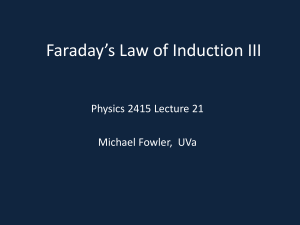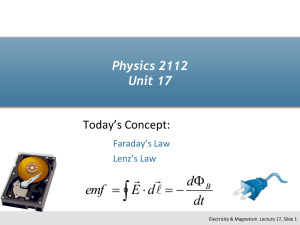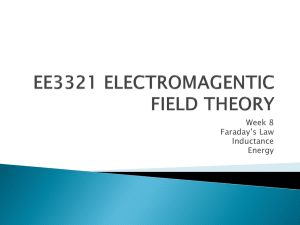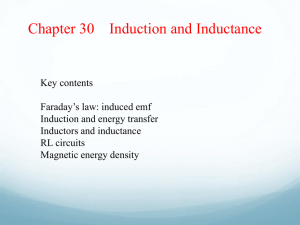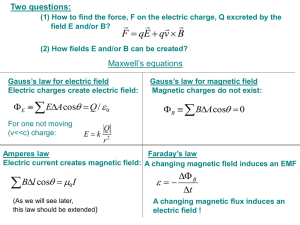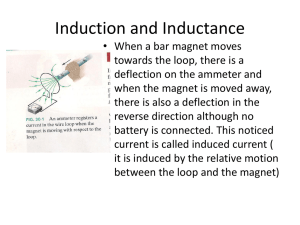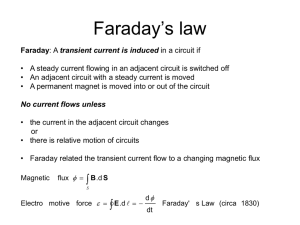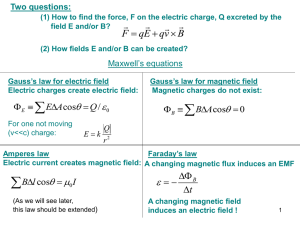Faraday Induction I - Galileo and Einstein
advertisement
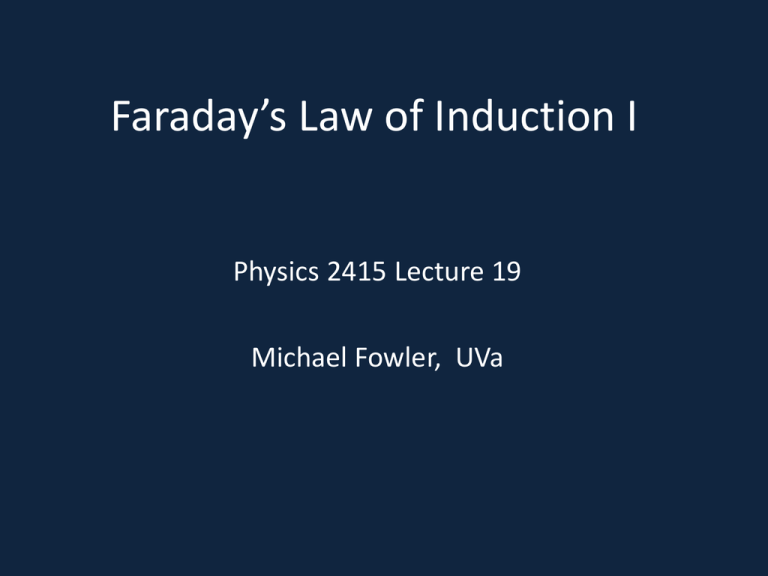
Faraday’s Law of Induction I Physics 2415 Lecture 19 Michael Fowler, UVa Today’s Topics • • • • Magnetic Permeability Faraday’s Law of Induction Lenz’s Law Paramagnets and Diamagnets Electromagnets • Electromagnets are solenoids • . with iron inside to magnify the magnetic field. • In the electromagnetic doorbell, pressing the button closes the circuit, the magnet pulls the bar and small hammer forward to ring the bell—and also to break the circuit, which passes along the bar to a contact at the top. The cycle repeats as long as the button is pressed. Magnetic Permeability • Putting iron inside the solenoid increases the magnetic field strength because the magnetic domains in the iron line up with the field (to some extent) and so add their magnetism to that of the solenoid. • The field inside a long hollow solenoid is: B0 = 0nI • For a solenoid filled with magnetic material: B = nI • This defines the permeability . For the ferrous materials used in magnets, it can be 103 – 104. Soft Iron Strengthens and Directs the Field • All the field here is • . generated by the current in the red solenoid, which is wrapped around the shaped piece of iron. • Another bar of soft iron is held a small distance below. Notice how little field there is outside the iron, except in the gap the lines must cross. Typical electromagnet configuration Faraday’s Idea • Faraday theorized that since an• . electric current could generate a powerful magnetic field, maybe a magnetic field could generate a current? • He tested this theory by winding two solenoids around the same doughnut shape of soft iron. • He ran a large current in one, looked for a current in the other—and didn’t find it. Faraday’s Discovery • He ran a large current in one, • . looked for a current in the other—and didn’t find it. • But he did find something! • He found a transient current appeared in the second coil at the moment the current in the first coil was turned on, then a transient opposite current when it was turned off. Induced EMF • Faraday discovered that what he called an “induced current” appeared in a coil whenever the external magnetic field through the coil was changing. • We say there is an induced emf driving this current. • . One of Faraday’s experiments as portrayed in an 1892 physics textbook “for advanced students”. On the right is a battery, on the left a fancy galvanometer. Induced emf: the Facts • For a coil of N loops close together, the induced emf is N times that for one loop (meaning the current will be the same if there’s negligible external resistance in the circuit). • For a uniform magnetic field, the emf is proportional to the area of the loop. • It’s proportional to the component of magnetic field perpendicular to the area. • It’s proportional to the rate of change of field. Magnetic Flux through a Loop • Recall Gauss’ theorem related flux of electric field through an area enclosing a volume to the charge inside. • Faraday introduced the concept of magnetic flux through a loop: the loop is “roofed” with a surface having the loop as boundary, the magnetic flux through the loop is B B dA • . dA B The integral is over the surface, adding contributions from tiny squares. Faraday’s Law of Induction • Faraday’s law of induction states that when the magnetic flux through a loop is changing, there is an induced emf in the loop given by: E • . I N Magnet moving up dB dt • You get the sign of the emf from Lenz’s law… S Lenz’s Law • The direction of the induced emf generated by a changing magnetic flux is always such as to oppose the motion. • Example: as the N pole moves up towards the loop, the current induced generates an N pole underneath to repel and slow down the approaching magnet. • . I N Magnet moving up S Another Way to State Lenz’s Law • The direction of the induced emf generated by a changing magnetic flux is always such as to oppose the change in flux through the loop. • Example: as the solenoid switches on, creating upward magnetic flux through the loop, the current generated in the loop will add downward flux. • . I Solenoid just switching on Pulling a Loop out of a Field • A square loop of side d is • . moving at speed v out of a region of uniform field B. • The induced emf is E d B / dt Bvd • What about direction? The downward flux through the loop is decreasing, the loop will try to oppose this by making more downward flux (Lenz’s law). B perpendicular down speed v d In time dt the loop will move distance vdt, so the area of lost magnetic flux will be vdtxd. Pulling a Loop out of a Field II • There’s another way to see • . this induced emf! • A charge q in the left hand side wire is moving at v along with the wire through the field B, so will feel a force qv B upwards. This is equivalent to an electric field, which acting the length of the side gives a potential difference vBd: this is the induced emf. B perpendicular down speed v d Current Loops and Atomic Currents • An approaching magnet generates an opposing current in a wire loop, but the current encounters resistance and soon dies away. • An approaching magnet also causes electric current in atomic orbitals to oppose it—this effect is small, but does not die away—there is permanent repulsion. It’s called diamagnetism, and is present in all materials. Paramagnetism and Diamagnetism • If the atoms of a substance are individually magnetic, they will tend to line up with an outside magnetic field – this is paramagnetism, and it will dominate over the weaker diamagnetism. Examples include Al, Mg, Ca, O2. • For a few materials, nonmagnetic quantum forces align neighboring magnetic atoms, so the little magnets all work together: these are the ferromagnets, like iron. Reminder: Magnetic Permeability • The field inside a long hollow solenoid is: B0 = 0nI • For a solenoid with magnetic material inside B = nI • This defines the permeability . For ferrous materials used in magnets, it can be 103 – 104. Paramagnetism and Diamagnetism • The magnetic susceptibility m is defined in terms of the permeability by: m 0 0 So the vacuum has m = 0. • If m is positive, the material is termed 5 10 paramagnetic. Typically, m • If m is negative, the material is diamagnetic, examples include Cu, Au, Pb. m 10 5 . Clicker Question • A small magnet hangs below a large magnet as shown, magnetic attraction balancing gravity. • Is this equilibrium A. Stable? B. Unstable? C. Not enough information to know • . N S Clicker Answer • A small magnet hangs below a large magnet as shown, magnetic attraction balancing gravity. • Is this equilibrium A. Stable B. Unstable Because a small motion downwards will weaken the upward force, a small motion upwards will strengthen the upward force. • . N S Stabilizing the Equilibrium • We place disks of bismuth above and below the small magnet. • Bismuth is strongly diamagnetic: as the small magnet approaches, it will readjust bismuth atomic orbitals to generate significant repulsion. • . N S A Strong Diamagnet: Bismuth • Bismuth has m = -1.66x10-4, ten times stronger than most other materials. • A magnet attracts iron, it aligns the domains so that poles form in the iron. • For a diamagnetic material, the opposite happens—poles form to repel the magnet! Bi • This repulsion can be used to hold a small magnet in place. • . Perfect Diamagnetism: Superconductivity • If a superconductor is moved into a magnetic field, the magnetic force on the moving charges generates currents at the surface of the superconductor—these currents produce a magnetic field exactly canceling the original field inside the superconductor. So m = -1. • The superconductor repels the magnet. • Note: this is quite different from bismuth, etc., where the atoms are diamagnetic, no macroscopic currents arise. • Superconducting levitating train model Another one. More Diamagnetic Levitation… • Diamagnetism is usually weak, but a strong enough field (in this case 16 Tesla) can levitate ordinary material, for example a frog, making an appearance here inside a solenoid (in Holland). • .


